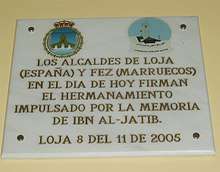Ibn al-Khatib
Lisan ad-Din ibn al-Khatib (Arabic: لسان الدين ابن الخطيب) (Born 16 November 1313, Loja– died 1374, Fes, Morocco) (Full name Muhammad ibn Abd Allah ibn Said ibn Ali ibn Ahmad al-Salmani) (محمد بن عبد الله بن سعيد بن عبد الله بن سعيد بن علي بن أحمدالسّلماني) was an Arab[1] Andalusian polymath[2] poet, writer, historian, philosopher, physician and politician from Emirate of Granada.[3] Some of his poems decorate the walls of the palace of Alhambra in Granada.

Al-Khatib was born at Loja, near Granada. For much of his life he was vizir at the court of the Sultan of Granada, Muhammed V. He spent two periods in exile in the Marinid empire in Morocco; (between 1360–62, and 1371–74, he resided variously at Ceuta, Tlemcen and Fes). In 1374, he was imprisoned for 'Zandaqa' (heresy) and atheism. He was sentenced to death by suffocation. Earlier and modern historians have speculated that his many private and political feuds in Granada with the Nasrid Kings of Granada, were probably the main factors in his treatment and execution. His body was burned before being buried at "Bab Mahruq", a city gate in Fes.[4]
He is highly esteemed both as an historian and as a poet. Some of his poems were put to music as muwashshahat.
His great historical work, al-Ihata fi akhbar Gharnata (The Complete Source on the History of Granada),[5][6] written in 1369, includes his autobiography. This work has yet to be translated into English.
On the Plague
In his treatise about the plague (Muqni'at al-Sā'il 'an al-Maraḍ al-Hā'il), (ca.753/1362), Ibn al-Khatib explores the idea of transmission of disease through contagion, centuries before Louis Pasteur conducted his experiments in Europe. The original Arabic text is preserved in the Biblioteca del Real Monasterio de El Escorial, MS Arabic 1785.[7] Of the estimated deaths due to the outbreak of bubonic plague, known as the Black Death, that swept through al-Andalus in the 14th century, the numbers range to as high as a third of the Muslim population worldwide.[8]
In his treatise On the Plague, Ibn al-Khatib writes:[9]
"The existence of contagion is established by experience [and] by trustworthy reports on transmission by garments, vessels, ear-rings; by the spread of it by persons from one house, by infection of a healthy sea-port by an arrival from an infected land [and] by the immunity of isolated individuals."
While the plague hadith indicated that the Prophet suggested otherwise,
"a proof taken from the traditions has to undergo modification when in manifest contradiction with the evidence of the perception of the senses."[8][10][11]
This may have led to his execution by strangulation for "heresy".[8]
List of works
- The Badr View in the Nasirian State - Al-Lamhat al-Badriya fi al-Dawla al-Nasriya, ed. Arab & Latin transl. M.Casiri, Biblioteca arabico-hispana escurialensis, II, Madrid 1770.
- Compendium on Granada (in 5 vols.) - Al'Ihatat fi 'Akhbar Ghurnata (Arabic) [12]
- The Scholars' Recitations of Dreams of the Kings of Islam
- Biographies, Dates and Connections - 'Awsaf an-Naas fi al-Tawarikh wa'l-Salaat (Arabic)[13]
- A Clerk after the People Move (Politics of Granada & Morocco) - Kanasat al-Dukan baad Intaqal as-Sakan[14]
- Calibrate Selection in Institutes of Mind
- Views of Sanseddin Ben Khatib in Morocco and Andalusia
- Malaga and Sala
- The Masterpiece of the Book and the Purity of the Elect
- Manuscripts
- Magic and Poetry
- The Book of Rehana and the sorrow of the Creator
- Garden Definition of Sharif Love[15]
- A Message in Politics
Bibliography
- Jaysh Al-Tawshih of Lisan Al-Din Ibn Al-Khatib (Arabic), An Anthology of Andalusian Arabic Muwashshahat, Alan Jones (Editor), 1997 - ISBN 978-0-906094-42-6
- Lisan Al Din Ibn Al Khatib, Tarikh Isbaniya Al Islamiya (history of Muslim Spain), ed. by Levi-Provencal, new edition, Cairo, 2004
- Lisan Al Din Ibn Al Khatib, Awsaf Al Nas (description of peoples), Cairo, 2002
- Lisan Al Din Ibn Al Khatib, Khaṭrat al-ṭayf : riḥlāt fī al-Maghrib wa-al-Andalus, 1347–1362, 2003
- Lisan Al Din Ibn Al Khatib, Nafadhat al-jirab (the Ashtray of the Socks)
- Lisan al-Din ibn al-Khatib homme de lettres et historien, by Abdelbaqui Benjamaa, (French) thesis, Universite de la Sorbonne Nouvelle Paris III, 1992 (microform).
See also
References
- ↑ Farhad Daftary, The Assassin Legends: Myths of the Isma'ilis, (I.B.Tauris, 1994), 160.
- ↑ Alexander Knysh, Ibn 'Arabi in the Later Islamic Tradition, SUNY Press (1999), p. 172
- ↑ Encyclopedia of Medieval Iberia, ed. Michael Gerli. (New York: Routledge, 2003), 416–417
- ↑ Awasaf an-Nas fi Tawarikh wa Silat, pp19, Mohamed Kamal Chabana
- ↑ ed. Muhammad Abd Allah Inan (Cairo: Maktabat al-Khanji, 1978)
- ↑ AlIehataFeyAkhbarGernata_الإحاطة في أخبار غرناطة.
- ↑ M. W. Dols, The black death in the Middle East, New Jersey, 1977, 322. M. Aguiar Aguilar, "Aproximación al léxico árabe medieval de la epidemia y de la peste", Medicina e Historia (2014) http://issuu.com/fundacionuriach/docs/m_h_2_2014_v7_r
- 1 2 3 Kadri, Sadakat (2012). Heaven on Earth: A Journey Through Shari'a Law from the Deserts of Ancient Arabia ... macmillan. p. 185. ISBN 9780099523277.
- ↑ Byrne, Joseph P. Encyclopedia of the Black Death. ABC-CLIO. p. 182. ISBN 1598842536.
- ↑ Arnold, Thomas W. and A. Guillaume, Legacy of Islam, Oxford, 1931, p.340
- ↑ c.f. Ober, William B., and Nabil Alloush, "Plague at Granada, 1348-1349: Ibn al-Khatib and Ideas of Contagion." Bulletin of the New York Academy of Medicine, v.58, n.4 (1982), pp.422
- ↑
- ↑
- ↑
- ↑ rawdhatarif.
External links
| Arabic Wikisource has original text related to this article: |
- Poem by Ibn al-Khatib sung by Fairuz (click on the oval above the poem)
- Ibn al-Jatib (second part of the page is in English)
- Website Ibn Kahldun: Ibn al-Khatib, retrieved on feb. 2, 2008
- Encyclopedia of medieval Iberia, Ibn al-Khatib, retrieved on feb. 2, 2008
- Ibn al-Khatib. Polymath Virtual Library, Fundación Ignacio Larramendi